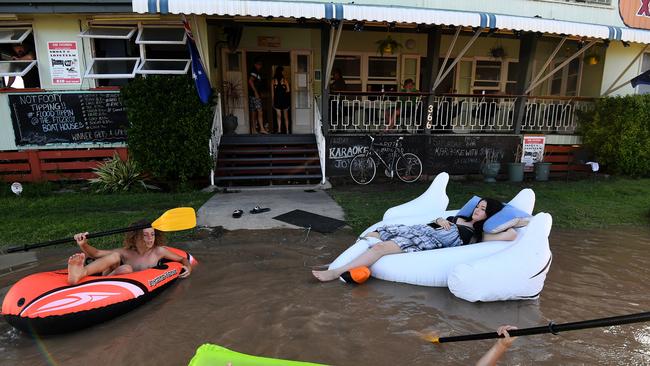Water storage levels 'made damage worse'
DAVID Goodwin and his family drove up to Wivenhoe Dam on the afternoon of Sunday, January 9, to witness the release of water from the dam's gates.
DAVID Goodwin and his family drove up to Wivenhoe Dam on the afternoon of Sunday, January 9, to witness the release of water from the dam's gates.
When they got there, the Queensland Chamber of Commerce and Industry president was struck by something he regarded as odd.
The volume of water coming through the gates was not nearly as large as he had expected, given the rising levels in the flood compartment, the widespread rain, the warnings of La Nina-linked extreme wet weather on the way and the onset of the wet season.
"It was not the time to be holding water when you're coming into the wettest time of the year and the dams are already at full capacity for water supply," Mr Goodwin told The Australian.
"As someone who stood near the spillway that afternoon, I was surprised at the relatively moderate volumes coming through."
The official records from SEQWater show that, at 6am on Friday, January 7, Wivenhoe Dam, Brisbane's insurance policy to protect the city and surrounding suburbs from a massive rainfall and flood event, was at about 106 per cent capacity. This means that Wivenhoe had filled to 100 per cent of its capacity for water supply with a total 1.15 million megalitres, and it was 6 per cent into its additional 1.45ML of storage for flood mitigation.
On Saturday, January 8, it is understood to have let about 100,000ML go; on Sunday, when Mr Goodwin's family was there, a further 116,000ML were released.
By 9am on Monday, the levels in the dam had soared to just over 148 per cent, and it was reported that managers at the dam had "scrambled".
That afternoon, the extreme rainfall over Toowoomba and the Lockyer Valley unleashed a maelstrom that the Bureau of Meteorology had not predicted. While the run-off from this event did not fall into Wivenhoe's catchment of about 7000 sq km, the dam's operators were caught by surprise and released 172,000ML as the capacity went past 150 per cent.
Through Tuesday, as Wivenhoe continued to rise past 175 per cent and then 190 per cent, the situation was becoming critical as the available buffer for more rain had been almost fully taken up. Nobody wanted the dam to go to 200 per cent, and the theoretical maximum of 225 per cent needed to be avoided at all costs.
One of the crucial questions that will be asked in a commission of inquiry, called late yesterday by Premier Anna Bligh, is whether the releases from the flood storage compartment of a little over 200,000ML on the weekend were too little, too late, necessitating a huge outpouring to get levels down quickly.
The operators of the dam gave the order on Tuesday, cranking up the release to a staggering peak rate of 645,000ML a dady. At that point the Brisbane River flood was not a case of if but when: the computer modelling showed major flooding from this Wivenhoe discharge was inevitable and would peak in the 36 hours the water would take to reach the city gauge.
The release from Wivenhoe at a peak rate of 645,000ML a day represented up to 30 per cent of the dam's total capacity. Nobody was under any misapprehension about the consequences. It was this release from Wivenhoe that represented about 80 per cent and perhaps more of the volume in the Brisbane River.
A rainfall event that could have been comfortably managed by the dam if its flood compartment had been lower had turned into a major flood that would devastate thousands of homes.
SEQWater has strenuously defended its actions and insisted that its operators on the weekend acted professionally and strictly according to the manual, adding that they could not foresee the worsening weather.
Mr Goodwin, who represents thousands of small business owners, wants to know why the dam was not releasing more water over the weekend, when he visited.
Some engineers and hydrologists who are not involved in the dam's operations but who have studied the release data believe the Brisbane River flood was mostly attributable to the fact the dam had stored too much water over the weekend.
"A release of 116,000ML on Sunday and then 645,000ML on Tuesday is just so disproportionate -- and it demands explanation," Mr Goodwin said.
"I want to know why the dam's operators did not release much sooner than they did . . .
"I want to know why it is prudent that you run your biggest dam at 100 per cent of its supply level at the beginning of the wet season."


